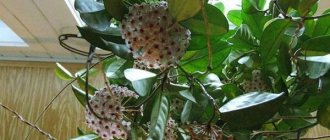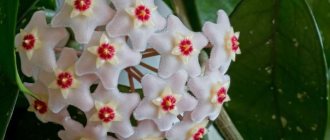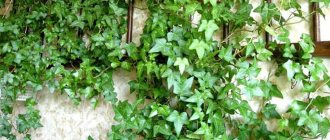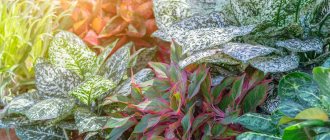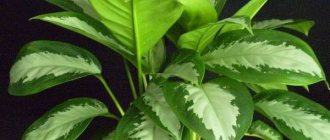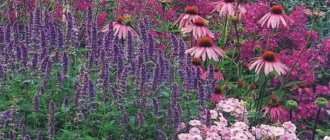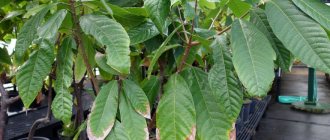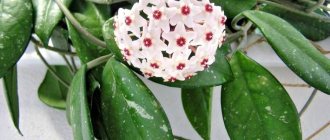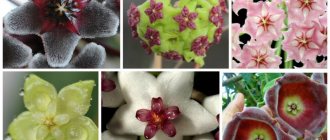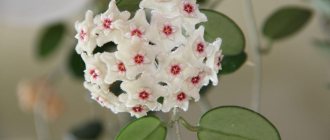Hoya is an exquisite evergreen tropical plant, a liana in which the surface of the leaf blade is as if covered with wax. It is perfect for landscaping an apartment and, with its decorative effect, gives the room in which it grows a unique coziness. Housewives often call Hoya simply - wax ivy. Caring for Hoya at home is quite simple, because wax ivy is considered a very unpretentious plant. She is not capricious and is grateful for the slightest care from her owner.
Story
Hoya received its name from the then famous botanist Robert Brown, the author of the theory of “Brownian motion”. In 1810, he described just this type of hanging vines and gave them the name of his friend Thomas Hoy, the gardener of the English Duke of Northumberland. Thomas worked for many years in the Duke's greenhouse and devoted his entire life to growing tropical plants.
Hoya belongs to the Lastovnevye subfamily in the Kutrovye family. In total there are over 200 varieties of Wax Ivy. Most often, the flower can be found in the forests of Asia, on the west coast of Australia, and in southern China. It grows in Madagascar and the Canary Islands. In tropical areas, it lives in open forests, where it spreads along rocky slopes and clings to sparse trees. Reaches a length of ten meters.
Care
There is an opinion that Hoya is capricious and difficult to care for. This is wrong. It is quite difficult for her to create conditions in an ordinary standard apartment, but with all the favorable factors, the flower no longer requires large expenses. The rules for caring for it are no more difficult than for any other indoor flower.
Watering
Water the hoya every 2 days in summer. With a properly selected substrate, there is no risk of flooding - water instantly passes through it and drains, preventing the roots from rotting. You can water from the top or simply lower the flowerpot into water for 15-20 minutes (like an orchid).
It is desirable that the water for hoya be not just room temperature, but a little warmer - 35-40 °C. In the spring, before the first buds are laid, wax ivy is even bathed. Keep the flowerpot under warm “rain” or immerse it completely in water, first tying it with film at the roots so that the soil is not washed away.
Feeding
Starting in spring, the plant is fed with special complexes for orchids. Hoya is sensitive to overfeeding, which causes it to stop blooming and become sick. Therefore, if it is not possible to buy special fertilizers for epiphytes, it is better not to fertilize the flower at all.
Important! Hoya cannot be fed with organic matter. Traditional fertilizers (tea leaves, banana peels, herbal decoctions, yeast, etc.) can destroy the plant!
At the end of summer, all feeding is stopped. The flower needs rest; during the dormant period it requires a minimum of nutrients. In autumn, it is only allowed to occasionally wipe or spray hoya leaves with a special product for orchids in a spray or in the form of napkins.
Transfer
Plants up to 3 years old are replanted every year. This is necessary to replace the substrate and update its nutritional composition. Use the same pot. Hoya does not grow roots too quickly; it will be uncomfortable in a large container, and it will have to wait longer for flowering.
Before transplanting, the hoya is watered and then removed from the pot. It is not necessary to completely shake off the substrate around the roots so as not to damage the smallest roots. A new nutrient composition is poured into a flowerpot, a flower is placed there and carefully sprinkled on top. If there is a knot in the center, it is important not to fill it.
Keep 2-3 cuttings in one pot at a time. This way the bush will be more lush, and this will not interfere with growth and flowering. At the same time, the pot should not be large - a good substrate with regular watering and fertilizing will provide the Hoya with enough nutrients.
Garter plant
Long flexible vines need staking. Therefore, even before planting, it is necessary to think about where and how the supports will be located. Most often, hoya is tied to an arch above a flowerpot, forming a “basket”. It is easy to install a trellis or plastic mesh to which the branches will be tied.
Many simply send shoots along the slopes on both sides of the window sill. The inconvenience is that this way the plant cannot be moved from its place, which makes cleaning difficult. Even opening a window can be problematic. It would be convenient to let the vines run along the wall, but this way the hoya will most likely have little light.
Only bush forms of wax ivy are cut short. They are able to form buds even directly from the root. The rest (and most of them) cannot be grown in the form of a bush. Their flower stalks are formed on vines no shorter than 30 cm. This is important to remember and take into account when forming a plant.
Shaping and trimming
Some Hoya varieties grow quickly and require constant pruning. It is usually advised to leave 5-6 leaves on each shoot (40-50 cm), and remove the rest with a special pruner. The branches must be cut strictly between the nodes without damaging them. The removed part serves as a cutting - it is placed in water or immediately placed in nutrient soil.
If the task is to grow hoya in an ampelous manner so that the shoots hang down freely, then pruning is not required. To make the bush lush, plant 2-3 plants in one pot, turning them in different directions. Then the composition will turn out lush and harmonious. In this case, there is no need to trim the vines.
Description
Hoya is a beautifully flowering evergreen vine. At home it grows to a maximum height of 5 – 6 meters. Young leafless shoots of the vine are brown with shades of purple. As they grow older, when young leaves and aerial roots begin to appear on them, the shoots turn green, and then, over time, become woody. The leaves of the vine are leathery, with moderately pronounced fleshiness, as if covered with wax, with small inclusions of gray color. Different species of Hoya have leaves of different sizes and are colored in different shades of green. The leaves, shiny at a young age, gradually become dull. They are ovoid, oval or heart-shaped and have fleshy, leathery axillary inflorescences. Hoya flowers are collected in umbrellas. Sometimes up to 50 flowers are collected in one umbrella. The flowers have different shapes, but all have five rounded petals. The diameter of each flower is 1–2 cm, except for the flowers of Hoya imperatoria, which reach 8 cm in diameter. In the center of the corolla of the flower there is a five-membered crown rising above the petals. The flowers are velvety in appearance, white, brown or greenish in color. Each bud blooms and stays in the inflorescence for about three weeks, after which a new flower appears in its place. Hoya blooms at the end of May and blooms all summer and half of autumn. During flowering, a huge amount of nectar is released - Wax Ivy is a honey plant. At the peak of flowering, its aroma can drive any gardener crazy!
This is a completely harmless flower. It is not part of the poison ivy family. The plant does not suppress the growth of other flowers in the apartment. Many psychics claim that this beauty, with her energy, reduces aggression and rivalry between everyone who neighbors him. Therefore, wax ivy can be found in almost all office buildings to create a calm working atmosphere. Very rarely, the fragrant smell of a flowering plant causes a headache. Allergy sufferers also need to be careful when contacting Hoya flowers so that they do not cause dermatitis on the skin. But in general, you will get a lot of pleasure and a cozy atmosphere in your home from growing Hoya!
Purchase and adaptation
Almost all types of this indoor culture are easily available - you can purchase them at any flower shop. The choice should be approached responsibly, because the future health and decorativeness of the adult flower will depend on the quality of the seedling.
Hoya bella care at home photo
The criteria for choosing a quality plant are as follows:
- the stems are flexible, uniform, without mechanical injuries and damage by diseases and pests;
- the leaves are juicy, rich in color in accordance with the variety, do not contain yellow, black or brown spots or holes;
- the soil is slightly moist, without mold or acidification on the surface;
- through the drainage holes you can determine the condition of the roots - they are dark brown, without rotting parts and plaque.
Shake off the crown - if the leaves do not fall off, then the plant is fresh and can be purchased.
The purchased flower must be kept in quarantine for 2-3 weeks to make sure that it is not sick. During this time, he adapts to room conditions.
Types and varieties of Hoya
In indoor floriculture, Hoya is grown in different ways:
- as an ampelous plant in a flowerpot;
- like ivy around a support;
- like a bush with an erect stem.
To do this, select the appropriate type of Hoya.
Hoya majestic
The homeland of Hoya Majestic or Imperial (Hoya imperialis) is the Malacca Peninsula. Grows as a climbing shrub. The leaves are oval-shaped, oblong, with a slightly pointed tip. They are large, up to 20 cm in length. The surface of the leaves is smooth and leathery. The flowers are collected in hanging umbrellas of 6 - 10 pieces. They are dark red inside and yellowish green outside. Their petals look like stars and smell pleasant.
Hoya Beautiful
Hoya Bella is an ampelous type of plant. Brought from India, perfectly adapted to high room temperatures and humidity. It has the appearance of a small shrub with creeping shoots, which are covered with small, thick, pointed leaves up to 2.5 cm in length. It blooms with medium-sized white flowers, the crown of which is a unique red or red-violet color. Blooms profusely throughout the summer. The aroma of this type of Hoya is less pronounced than others, so the flower can be placed almost anywhere in the apartment.
Hoya Greenflower
Hoya Chlorantha is a very showy plant with elongated leaves and velvety flowers of white, brown or greenish color.
Hoya Fleshy
Hoya Carnosa is a very popular vine among gardeners. It grows naturally in India, China, Vietnam, Malaysia, and Japan. Reaches a length of 6 meters. It is necessary to tie it up or install a ring support so that the thin stems of the plant wrap around it. This type of vine has different flowers depending on its variety. Thus, the variety Variegata has flowers of a pinkish tint with a white edge, and Tricolor has leaves that have a green edge, and the middle is first colored red, and changes to yellow as it grows. Hoya Exotica has leaves with a yellow center and green edges. The Crimson Queen variety has bright pink flowers with a pale pink edge.
Hoya Motoskei
Hoya Motoskei is a long, up to 6 meters, vine with drooping creeping stems. Its dark green leaves are oblong or heart-shaped. They are fleshy and shiny in appearance. The leaf length reaches 8 cm, and the width is up to 4 cm. The flowers of the vine are pale beige or white, with a pink crown in the center. They are collected in umbrellas and have a very pleasant aroma.
Hoya Multiflora
Hoya Multiflora was brought to us from Malaysia. It grows in the form of ivy with linear oblong leaves. It blooms early with long orange flowers with narrow yellow petals in the shape of a star with a tip-shaped center. It most often has large leaves, although there are species with small leaves.
Hoya Kerry
Hoya Kerri is another ivy-like species. This variety of Wax Ivy was discovered in 1911 by the American scientist A. Kerry in northern Thailand. This vine was named in his honor. Very beautiful view. Long stems need staking. The pubescent flowers are collected in spherical umbrellas of 15 - 25 pieces. Their color depends on the plant’s exposure to sunlight: from white with a barely noticeable lemon tint to yellow-lemon and pinkish. The older the plant, the darker its flowers become. It is distinguished by an unusual leaf shape - in the shape of a heart. This flower is called Valentine or Hoya of lovers. In order to grow this amazing plant, it is enough to plant one heart in the ground - very soon it will take root.
Hoya Concave
Hoya Lacunosa lives in Malaysia. It has small diamond-shaped leaves, light green in color with a darker edge. Flowers have a subtle, pleasant aroma, similar to perfume. This type of vine is considered the most unpretentious to care for and is very popular among novice gardeners.
Hoya Cupulata
Hoya Cupped (Hoya Calycina) is an upright plant species. Its difference is in the leaf plates - they are the longest, up to 20 cm in length.
This may be interesting: Adenium - desert rose
The necessary conditions
Hoya is a very tenacious plant, but to see it in bloom, you will have to fulfill all the required conditions. Otherwise, the plant may produce new leaves for years, increase green mass, but not form a single bud.
Humidity
The flower loves humid and warm weather. In nature, these are the conditions that stimulate the flowering of this epiphyte. At home, from spring to autumn, wax ivy must be sprayed at least once every 3-4 days with warm water. There is no point in placing pallets next to each other - it will not help the plant in any way.
In winter, when the air in the apartment becomes dry, many flowers suffer. However, hoya tolerates this time well without additional moisture. She enters a dormant period, in which all she cares about is temperature, lighting and rare but abundant watering.
Temperature
All epiphytes are thermophilic. In their natural environment, these plants are not accustomed to a sharp drop in temperature; there is not even winter there in the usual sense. The most optimal temperature for hoya is +22-25 °C in summer and +17-20 °C in winter. During the dormant period, it is important to keep the plant a little cooler. Then flowering next year is guaranteed.
Lighting
Hoya needs a lot of light. Its powerful, fleshy leaves consume solar energy in large quantities. They cannot live well in the shadows. To bloom, the pot will have to be placed in the brightest, direct sun. This plant is not afraid of burns; it does not need to be shaded.
Important! The light on the flower should fall evenly and always the same. It should not be rotated and rearranged frequently - there is a risk of dropping flower stalks and even the leaves themselves.
Caring for Hoya at home
For home cultivation, Hoya is usually purchased in two types: Beautiful or Fleshy. In order for Hoya to grow well in your apartment, you need to create conditions for it that are close to its usual tropical conditions. Here are the basic rules for caring for a flower.
Flower content temperature
Hoya feels great at a normal room temperature of 20 - 30 °C. Loves fresh air - ventilate the room. But it is not at all necessary to take it outside. Moreover, you should not expose her to cold drafts. Wipe off dust from the leaves and spray them regularly. In winter, the flower will withstand temperatures dropping to 15 °C. But the temperature is below 10 °C. The Hoyas may not survive. Winter flower maintenance at 16 – 18 °C. necessary for regular annual summer flowering of Hoya. This period of Hoya’s life is considered conditionally a period of rest.
Yellowing and falling leaves are often a sign of flower hypothermia!
Location and lighting
If the plant does not like its location, it may not bloom. Let's consider all the options in order.
Hoya is not afraid of a little shade. If you place it near eastern or western windows, it will not only grow well, but also bloom profusely all summer and until mid-autumn. It must be protected from direct sun. As one option, you can place the vine against the wall in the southern room. Like an hanging plant, it will cover the entire wall and become the highlight of your home.
But, one should take into account the fact that Hoya does not like to be moved from place to place. If you move it from place to place or hang it on other walls, then it will simply lose all the buds and even shed all the leaves. This plant is completely unsuitable for summer landscaping on balconies, loggias or verandas.
You should not place the pot on the windowsill - it will not tolerate direct sunlight, and it will not like the proximity of heating devices in the autumn-winter time - Hoya may get sick and die.
The daylight hours should be long enough. If cloudy days occur during flowering, it is advisable to improve its lighting using a fluorescent lamp or phyto lamp so that daylight lasts at least 12 - 14 hours a day. The same applies to the winter period of her life, only 10 hours of lighting per day will be enough.
When choosing a place for a flower, you must remember that during flowering Hoya emits such a strong aroma, especially at night, that you will definitely want to take it out, for example, from the bedroom (which can lead to the shedding of not only flowers, but also leaves), or you will have to constantly ventilate the room.
And one more important condition. For trouble-free growth and development of the plant, different types of support are needed: posts, trellises, trellises, all kinds of arcs in the shape of a heart, ring or arch. They are simply necessary in order to tie to them numerous flexible and rather long shoots of the plant - vines. Although, it is possible to grow Hoya as a shrub. Then you will have to frequently pinch out the growing shoots.
Features of Hoya flowering
Tropical liana loves bright but diffused sunlight. Receiving it in abundance, Hoya will bloom profusely and for a long time with beautiful fragrant inflorescences. Choose the location of the flower so as not to move the pot from place to place during the period of bud formation and flowering, since the plant can partially shed both buds and flowers. Stems with clusters of flowers should be securely supported so that they are always in an upright position. After flowering, long shoots should be cut off, but short and flowering shoots should be left.
Do not touch the flower stalks either - after a while buds will appear on them again.
Watering
From March to October, Hoya should be watered regularly and moderately. About once a week. The water should be soft. If you use chlorinated tap water, it should sit for 24 hours so that all impurities precipitate and the chlorine evaporates. Be sure to remove excess water that has accumulated in the pan so as not to provoke rotting of the root system of the flower. In summer, it is necessary to water the plant after the soil has dried out from the previous watering to about one to two cm from the surface. From November, watering is reduced. The plant is watered a couple or three days after it is noticed that the top layer of soil has become dry. About twice a month. You shouldn’t water Hoya at all in the autumn-winter period - its roots will begin to die, and by spring the plant will become weakened and may die.
Bathing
Twice a year, in the spring before flowering and in the fall after flowering, Hoya is bathed. A pot with a flower is lowered into a large basin with hot water heated to 30 - 40⁰C. After 7 - 10 minutes, the stems of the plant are pulled out of the water, and the earthen lump remains in the hot water for another half an hour.
This may be interesting: Poinsettia - Christmas star
Spring bathing will significantly speed up the approach of flowering and promote rapid growth of ivy. Autumn bathing will harden the flower and give it strength to survive the difficult winter time.
Ambient humidity
For Hoya, air humidity is not a determining factor. It will grow at normal room humidity. If the air in the room is too dry, it is enough to place the flower pot in a tray with wet expanded clay and regularly spray the surrounding air.
Transplant and pot
The liana grows quite quickly. Within a year, its length will reach 30 cm. Its roots also grow. Therefore, we recommend replanting young plants every spring into new pots, 2 - 3 cm larger than the old ones. Keep in mind that in a more spacious pot, Hoya will feel more comfortable, its shoots will grow faster, adding 30 - 50 cm per year. But in a slightly cramped pot it will bloom more profusely. Therefore, you choose what is more important to you in the coming year - either to grow more young shoots, or to make Hoya bloom profusely. Hence the size of the new pot.
An adult plant needs to be replanted less often - once every 3 - 4 years. The optimal pot size for an adult plant is 18 – 20 cm.
Replant by transferring the plant along with the earthen ball into a new pot. Do not forget about drainage - expanded clay or broken shards, laid at the bottom of the flowerpot at a third of its height. If there is a need to completely replace the old soil with a new one, carefully free the Hoya root system from the old soil, remove dried or rotten roots, and powder the cut areas with crushed coal. And only then plant the plant in a new pot and cover it with new nutrient soil.
It is better to choose a ceramic pot for Hoya, since its walls allow air to pass better to the roots. We recommend disinfecting any pot before use.
If you purchased a plant specimen in a store in bloom, you should not immediately replant it in your pot. Wait until the last inflorescences wither, and only then begin transplanting the plant from the store container into your own container. If possible, it is better to postpone this event until next spring.
Soil and fertilizing
Hoya prefers loose, breathable soil, neutral or slightly acidic, where the pH does not exceed 6.5. Usually the vine is not whimsical. Suitable soil consists of leafy soil, turf soil, peat, and sand. Add a little charcoal and pieces of sphagnum moss.
Of the ready-made mixtures for Hoya, soil for orchids is suitable.
Wax Ivy responds well to fertilizing with mineral fertilizers during the growing season. For Hoya, liquid complex fertilizers for orchids and other flowering succulents are suitable. One feeding every two weeks is enough. Do not violate the instructions; it is better to take fertilizers a little less than the norm - excess microelements will negatively affect the appearance of the flower.
Immediately after planting or replanting a plant, do not feed it for two to three months, provided you use nutritious soil. In winter, you should not feed the plant either.
Trimming
Frequent trimming and pinching is not really necessary for Hoya. In young plants, after the fourth leaf appears, the branch is pinched to form new shoots. Sometimes, in order to beautifully form a bush, Hoya shoots that are too elongated are pruned. Pruning is done with pruning shears. The stem is cut in the interval between the nodes. This pruning encourages the plant to produce new side shoots and encourages the plant to bloom profusely.
But you shouldn’t cut off the flower stalks after the inflorescences dry out - new flowers will appear on them in the future.
How to transplant a Hoya into a new pot
The “plus” of growing the crop is that it does not require frequent replanting. It is carried out, if necessary, once every 1-3 years in the spring. Recommended substrate: flower soil mixture “For flowering succulents” or prepared independently according to one of the “recipes” discussed above.
Usually, the plant itself signals that replanting is necessary: the root system protrudes from the drainage into the holes at the bottom of the flowerpot, the bush or vine does not grow, and the leaves become drooping.
Before replanting your home hoya, you need to choose the right new pot. If the goal is to get abundant flowering, then the container should not be much larger than the one in which the crop grew before. If it is necessary to stimulate the growth of a bush or vine, then the pot should be much more spacious than the previous one. You must not forget to place drainage at the bottom (pebbles, broken shards, stones measuring from 1 to 1.5 cm, foam chips).
Transplanting a healthy crop into a new container and fresh substrate is carried out using the transfer method - that is, an earthen ball entwined with roots is not destroyed, but is transferred to another container and supplemented with the required amount of soil. When planting, the hoya is not deeply buried; the transplanted plant requires standard care - as described above.
Hoya Reproduction
Hoya can be propagated at home in several ways.
Propagation by seeds
Hoya seeds
Obtaining and planting seeds is quite a troublesome task. Hoya seeds are rarely found on sale, and it is extremely difficult to obtain full-fledged seeds at home - they practically do not ripen. This method is most often used by breeders in large greenhouses. We'll tell you how this happens theoretically. After flowering, Hoya produces seeds. Only ripened and well-dried seeds are suitable for planting. They quickly lose their viability, so they are planted as soon as possible, at least in the same year they were collected. Hoya seeds are sown in a mixture of soil and sphagnum moss. The greenhouse must be kept constantly moist (not wet or dry), in a bright, warm place. Ventilate. Good seeds will hatch soon, a week after planting. Seedlings grow slowly. To prevent fungal diseases, we recommend spraying Wax Ivy seedlings with Bordeaux mixture or any other copper-containing preparation in strict accordance with the instructions. In about three months the first leaves will appear. Then it will be possible to think about transplanting young flowers into separate pots.
If you managed to collect seeds from a blooming Hoya at home and grow your own specimen from them, you have something to be proud of!
Reproduction by layering
A fairly simple and effective method of propagation. The new plant will bloom in the first year. To do this, choose a vine so that it can be placed in another pot, next door, on loose, nutritious soil, always with the addition of peat. The shoot with the knot is secured in the substrate with a pin. At the rooting site, a small incision is made on the shoot. This place is generously covered with moss, watered a little, and covered with plastic wrap. Such a greenhouse will stand next to the mother pot in a warm, bright place until roots form and young leaves appear. When you decide that the young shoot is strong enough, the shoot can be cut and separated from the mother bush. Now you can plant the Hoya layer with roots in a pot of suitable size and place it in a permanent place.
Sometimes, a branch with a notch is not placed on the soil in another pot, but is simply wrapped first in damp moss, then in polyethylene and tied well with twine. The same greenhouse effect at the cut site will lead to the appearance of roots. After a certain time, the branch is cut off for planting in a separate pot.
Propagation by cuttings
Hoya cuttings
This method is even simpler than the previous one. All spring and autumn you can propagate Hoya by cuttings. Select an area on last year's shoot with three internodes and two to three pairs of leaves. Sprinkle the cut area on the branch with crushed coal or treat it with garden varnish.
This may be interesting: Sansevieria (Sansevieria) - unpretentious perfection
Root cuttings either in water or directly in a nutrient substrate.
Let’s say right away that to fully guarantee survival, we recommend rooting several cuttings at once.
To root Hoya in water, you can add part of an activated carbon tablet to the water to eliminate infection, as well as Kornevin or Epin to stimulate root formation. Take warm, settled water. It is permissible to cover the container with a plastic bag, which is opened slightly for ventilation from time to time. The roots should appear in two to three weeks. Wait until they get stronger and grow a little. Then the cuttings can be transplanted into their own pots and placed in the place allocated for the flower. Sometimes, for a more beautiful flower arrangement, several cuttings are planted in one pot at once. In this case, choose a slightly larger pot.
When rooting Hoya in the substrate, sections of cuttings are also treated with Kornevin or Epin. The substrate should consist of three parts soil and part perlite and fine expanded clay. Stick the cuttings into the substrate so that the first internode is covered with soil. Cover the container with the cuttings with polyethylene or other transparent material. Place in a warm, bright place. The temperature should not be lower than 22 degrees. In two to three weeks, new leaves should appear, which means rooting was successful. Keep in mind that Hoya grown from cuttings will not bloom until the fourth year.
Leaf propagation
Only some species of Hoya can be propagated by leaves. For example, the Kerry variety is propagated by planting a leaf by cutting in a substrate under a film. For other species of this plant, this is the most unpredictable reproduction option. By planting a leaf in the substrate, you are not guaranteed to get a new plant. The roots of the leaf will appear very soon, but further growth may not be observed for a long time.
Transfer
Young hoyas are usually replanted every year. But the plant does not like changing the pot too much. Therefore, replant adult 3-4 year old specimens only when the need is ripe. The roots entwined the entire ground and grew into the drainage holes, and the flower stopped developing.
Hoya does not take well to changing the pot, do not disturb it unless absolutely necessary.
In nature, Hoya leads the lifestyle of an epiphyte or semi-epiphyte, so at home it needs a very airy and porous soil substrate. So that the roots receive enough air and do not suffer from stagnant moisture. Soil options for Hoya:
- ready-made soil for orchids or succulents, you can add loosening components;
- equal parts peat, perlite, coconut fiber and tree bark;
- one part each of soil for succulents, perlite, chopped sphagnum and pine bark and half part vermiculite with the addition of charcoal;
- into two parts of leaf soil, part of turf, peat, sand and humus;
- in equal parts a mixture of peat soil, perlite, crushed bark and coconut fiber.
Both plastic and ceramic pots are suitable for hoyas. But in favor of ceramics are good evaporation and high stability. Hoya is a rather weighty plant and often knocks over the pot. For long and high-quality flowering, the container needs to be tight, but for greenery to grow, it needs to be more spacious.
How to transplant hoya?
- Disinfect all components of the planting substrate. Boil the bark and chop it. Calcine, steam or treat the rest with a fungicide.
- Place drainage (fine expanded clay, pebbles, brick chips) at the bottom of the pot with holes. There is some soil on top.
- Remove the hoya from the old container without disturbing the earthen ball. Install it in a new pot. If the support for the vine is in a pot, place it immediately.
- Sprinkle the substrate between the wall of the pot and the earthen ball, compacting it a little. Pay attention to strengthening the support.
- Water the plant, you can spray it, place it in diffused light or partial shade.
Diseases and other growing pains
Excessive dampness and low indoor temperatures can cause fungal diseases of Hoya such as gray rot and powdery mildew. They can be easily identified by the gray or whitish spots that appear on the leaves. Powdery mildew can be treated quite successfully with chemicals and fungicides, but gray mold can destroy a plant in a matter of days.
Spots on Hoya leaves
If spots and thickening appear on the leaves, the Hoya may have a viral infection. Urgently isolate the flower from others and observe. If there is no improvement, the plant will have to be destroyed, since they have not yet learned how to fight viral diseases of flowers.
If the trunk and some shoots of the plant become soft, a sticky liquid with an unpleasant odor is released from them, the plant may have contracted a bacterial infection. It is necessary to spray the plant with copper containing preparations. Remove the affected parts of the plant.
Wax ivy can also develop non-infectious diseases, which usually arise from poor maintenance of the flower indoors.
We will tell you about the problems that most often arise when the rules for growing Hoya at home are not followed.
- Spots on the leaves appear either from excess sunlight, or from the use of cold water for irrigation, or from overfeeding the flower with mineral fertilizers.
- The leaves turn pale, curl and gradually dry out either from excess sunlight or from too low air and water temperatures for irrigation.
- Growth inhibition and pale color of greenery in Hoya can occur due to a lack of nitrogen fertilizers in the soil. It is enough to feed the plant with urea (1 g per 1 liter of water).
- Leaves can fall either from excess water in the soil or from its lack, or from high temperature and dry air in the room with a lack of watering.
- Reddening of the leaf blades is observed due to too hot air in the room or too much sunlight.
- Hoya sheds buds and flowers either due to moving the pot with a flowering plant to another place, or in case of constant overflow, or insufficient lighting.
- Excess moisture combined with poor drainage in the pot can cause root rot. Then the plant may die.
- Poor flowering of a flower is most often due to insufficient lighting. Hoya does not bloom without sunlight. And also, do not forget that some types of young plants bloom only in the second or fourth year after planting. Sometimes Hoya does not bloom at home due to the fact that it did not have a good rest during the winter. Some types of ivy simply need a break during the winter. Keeping it at a lower temperature, minimal watering, stopping feeding for two to three months, and returning after winter to a warm, bright place can force Hoya to bud and bloom profusely.
- Young shoots develop poorly, the lower leaves of Hoya turn yellow and fall off due to hypothermia of the plant at low air and soil temperatures.
Keeping in nature and at home
Hoya is an inhabitant of the tropics. And at home, she retained the habits acquired in nature. She still strives for the sun, prefers moist rather than dry air and fairly high temperatures. It is precisely about the winter temperature for hoya that gardeners often disagree. The traditional point of view is that hoya prefers a cool winter, + 12–16 0 C. But practitioners assure: hoya spends the winter well at moderate 18–20 degrees and even higher. Most likely, both are right. Some varieties, such as carnosa with succulent leaves, will benefit from cool temperatures. Only then should the humidity be low. And the tender Hoya Bella wants to live warm even in winter. So when creating a climate for your Hoya, take into account the natural conditions to which it is accustomed.
Table: conditions for hoya
| Season | Lighting | Humidity | Temperature |
| Spring | The bright, best place is on the western and eastern window sills, on the southern ones a little shading is required. The variegated forms need the most light. Monochromatic varieties grow well in partial shade, but then there may be problems with flowering. | High, 60–70 or more. Humidify the air in all available ways (double pot, tray with expanded clay or moss, indoor fountains, electric humidifiers). Spray leaves and stems more often. During flowering, stop spraying so that the buds and flowers do not fade. | Moderate, not less than +18 0 C. Protect from drafts. |
| Summer | Bright, diffused. Protect from midday sun. | Moderate, elevated is acceptable, optimally +20–25 degrees. Can be placed on a warm balcony or veranda. You should not take it out into the fresh air. Stems can be damaged by wind. And you don’t need to touch the plant that has buds. Hoya does not like changing places at this time. | |
| Autumn | |||
| Winter | Bright, with a short daylight hours, it needs artificial lighting. If there is enough light it will bloom in winter. | If the temperature is low, it does not need moisturizing. The warmer the room, the higher the humidity should be. Spray the plant, humidify the air in other ways. | For varieties with succulent leaves, cool, 12–16 0 C. For more delicate ones (bella) – moderate +18–20. When the temperature drops, it may lose its leaves. |
Flower growers advise bathing hoya twice a year, before and after flowering. A large container is filled with warm (about 40 degrees) water. The plant is dipped together with the pot and kept in water for up to 40 minutes. As they say, after taking a bath, hoya blooms better, and the autumn procedure hardens the plant.
To stimulate flowering, it is recommended to arrange a bath for hoya
Insects - pests
The main pest of wax ivy is the root nematode. When attacked by this parasite, Hoya stops growing, stops developing, yellow and then brown areas appear on the roots - they die. To destroy the pest, the plant is sprayed with one of the insecticides: Phosfamide, Lindane, Mercaptophos. Its roots are washed with hot (50 - 55 g) water, severely affected ones are cut off. The plant is transplanted into a new pot with nutritious soil.
Mealybug
Quite rarely, sucking parasites appear on the indoor Hoya flower: aphids, spider mites, mealybugs and others. You can understand this by the appearance of the plant. It loses its bright color, the leaves begin to turn yellow and fall off, growth slows down, the buds stop opening, and the flowers become sticky from insect secretions. It is necessary to carefully inspect the plant for damage by insects, especially in early spring, when young fresh shoots begin to grow. If any pests are detected in a timely manner, the flower is placed in the bathroom under a warm shower. Wash off insects from all parts of the plant. After the leaves have dried, spray Hoya with some insecticide, such as Karbofos, Fitoverm or Actellik. Processing is carried out according to the instructions. If after a week the insects have not completely disappeared, treat the plant again and again until you destroy them all.
How to take hoya cuttings to properly root the plant
In the question of how to properly cut hoya, special attention should be paid to pruning the cuttings. The best place for roots to appear is considered to be the area located under the node itself. Therefore, you need to leave a couple of centimeters of the stem under it, and cut off the rest. After a new shoot appears from the axil of the first node, you can cut off the second node and also root it.
Rooting is possible in one of two ways:
- Immediately in the substrate (at soil temperature +20...+25 °C).
- In water (at a temperature of + 22 ° C).
The first option is considered to be more reliable. Before rooting hoya cuttings, you need to prepare the soil according to one of the “recipes”:
- Mix equal parts of sphagnum moss (or peat), vermiculite (or perlite), fine expanded clay (or polystyrene foam).
- Combine fine expanded clay (1/5 part), perlite or vermiculite (1/5 part), planting soil (3/5 part).
The prepared substrate must be breathable so that the cuttings do not rot. Perlite or vermiculite will help ensure this soil property. You should also take care of the proper soil moisture, but the higher the level of its breathability, the faster the water evaporates from it. This problem can be solved using a plastic bag (how exactly will be discussed later).
Before rooting, for 100% results, you can treat the cuttings with Kornevin, but this is not necessary.
Hoyas - luxuriously flowering indoor vines
Hoyas are so popular that sometimes you can find them not in flower shops, but in gift shops. True, we are not talking about huge vines, but only about rooted leaves: green “hearts” that have taken root in a pot are an excellent gift for Valentine’s Day. But full-fledged hoyas have earned the status of one of the most “reliable” indoor vines. The plant received the “folk” nicknames “waxflower” and “wax ivy” for the seemingly waxy, unusually dense texture of the stars in the inflorescences and the special texture of the leaves.
Hoya is a genus of evergreen climbing, creeping or hanging shrubs and shrubs with long and thin shoots. The height of hoyas varies from 15 cm to 2 m. True, the tiny plants are the rooted leaves of Hoya Kerr, while all adult crops are much larger, although they are limited in height by the supports on which they grow.
Hoyas cannot be grown without supports, and choosing a specific shape and type of support allows you to modify the plant and its size as you please. Hoya leaves are dark, fleshy, but not too thick, leathery, always whole and located oppositely. And the shape and size of the leaves of individual hoi can be radically different.
Hoyas bloom from May to October. The flowers of this vine are unusually original, graceful, star-shaped, with an unusual double structure: inside the large five-pointed “star” there is a contrasting smaller star-crown. Both the shape of the stipules and their original waxy and sometimes almost furry texture made the plant stand out and become a legend. The stars of hoya flowers are collected in umbrella-shaped inflorescences, which most often droop and hang down like magical porcelain baskets.
Among the plants there are varieties with white, pink and cream colors, while almost always the star flowers are decorated with a dark or bright crown in the center. A distinctive feature of all khoyas is the ability to exude a surprisingly delicate aroma at night.
Hoya Kerrii. © Zoran Jovanovic
Stimulating the flowering of wax ivy
It is recommended to “force” the beautiful hoya to bloom in indoor culture. The plant will open flower buds on its own, but if you want to observe really lush flowering, then it is better to further stimulate the process. The procedures are especially important if it was not possible to ensure a decrease in temperature in winter.
To stimulate, the entire plant, at the beginning of active growth in the spring, is immersed in warm water (temperature - 34-36 degrees Celsius). You can limit yourself to soaking only the pot with roots in water of the same temperature. If you are soaking the entire plant, carry out the procedure for 30 minutes, and soak the pot for 2 hours.
It also stimulates abundant flowering and increased light intensity, including with the help of artificial lighting.
Fleshy Hoya (Hoya carnosa). © mainstream.01
